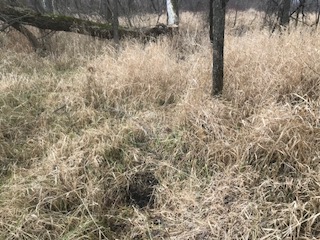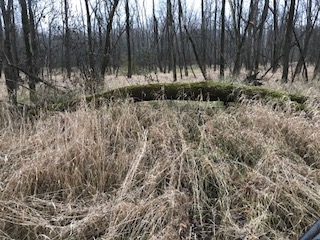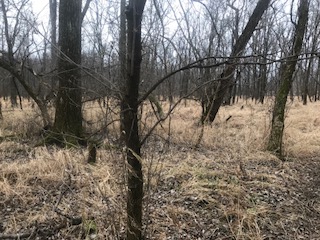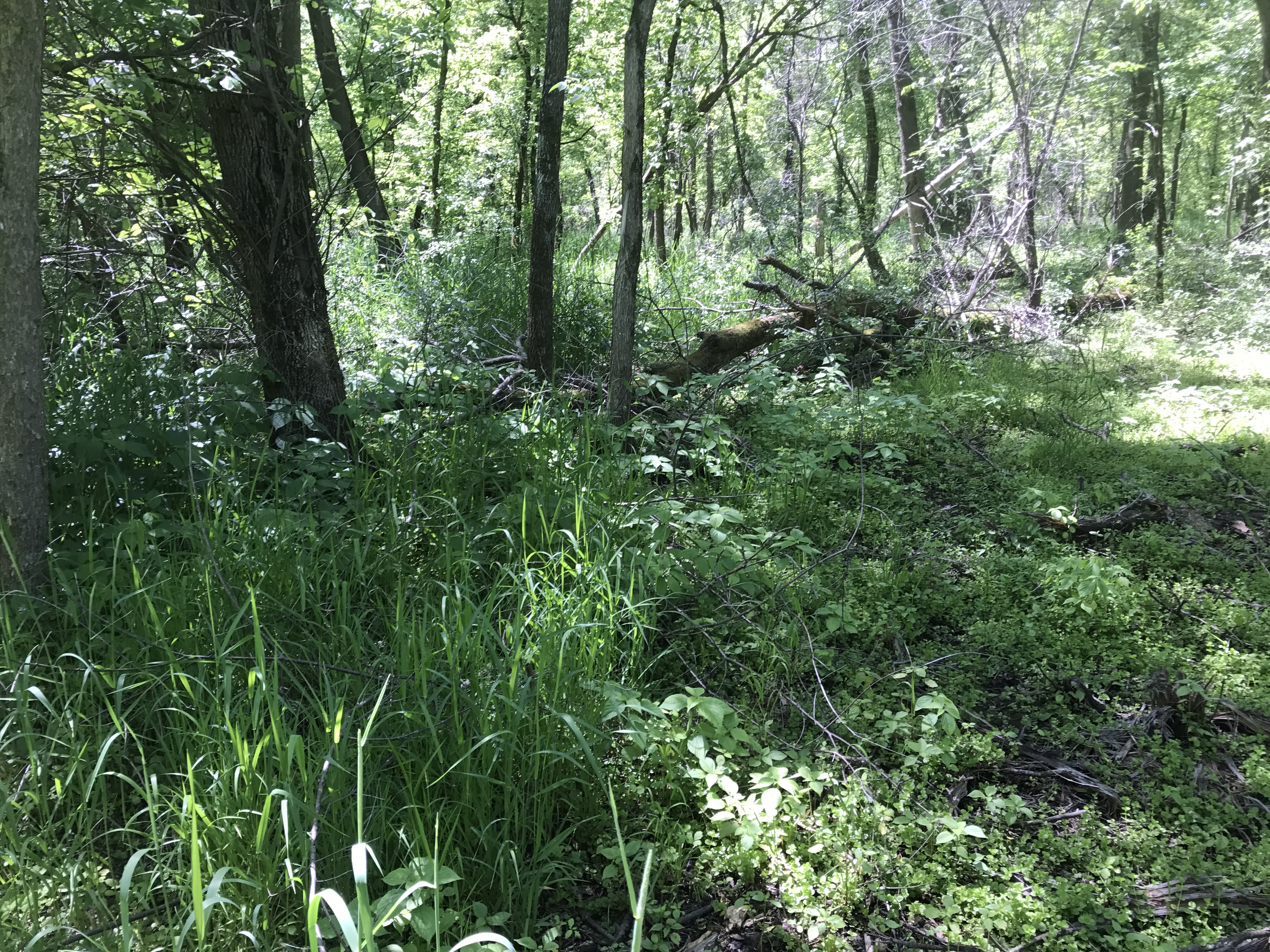Overview
A series of treatments to regenerate a floodplain hardwood forest stand that has been heavily invaded by buckthorn.
The treatments occur in three groups: a 26.26 acre block (treatment 1), a 37 acre block (treatment 2), and a 1 acre block (treatment 3).
Bottomland Hardwoods Stand Data
River or stream name: Mississippi River
River or stream type: Major river
Floodplain or terrace: Floodplain
Floodplain topographic position: Bottom
Silviculture Objective(s)
To regenerate a floodplain hardwood stand that has been invaded by invasive plants including buckthorn and garlic mustard.
To keep the area forested to continue providing watershed protection by stabilizing the riverbank, while also providing habitat and mast for birds and waterfowl.
Mixed hardwood species (mid- to shade-tolerant) should be planted under the existing forest canopy to mitigate potential future losses in the over story due to emerald ash borer.
Seedling stock will be dipped in Plantskydd solution (powdered solution mixed with water) and dormant stems sprayed in order to prevent deer browse.
Treat invasive species by treating small diameter buckthorn with a foliar spray, cutting larger buckthorn, and hand-pulling garlic mustard.
Pre-treatment stand description and condition
Pre-treatment species composition:
Overstory includes black ash, silver maple, red pine, and other mixed hardwoods. Stocking and density of buckthorn is variable; however, the shrub is quite dominant through much of the identified understory. Stand is roughly 85 percent stocked, and in the understory re-initiation phase. Separate stands of European buckthorn have been delineated within this unit. Two age-classes persist across much of the 26-acre unit as well.
Throughout almost all units, 1/8th inch diameter and 1 foot tall seedlings of various species are growing and are rather dense. Across approximately 15 acres of these units, buckthorn ranging from 0.5 to 2-inch diameter is growing overtop the seedlings.
Pre-treatment forest health issues:
Potential future loss of the stand's overstory due to emerald ash borer is a major health issue. Suppression caused by buckthorn shade and deer browse are other threats that are a concern as they could potentially prevent the replacement of a native species overstory.
Landowner objectives/situation:
The landowner wants to keep the area forested to continue providing watershed protection by stabilizing the riverbank, while also providing habitat and mast for birds and waterfowl.
Silviculture Prescription
All reed canary grass is to be spot-treated prior to planting.
Treatment Area 1:
In the summer of 2016, once the site is accessible and spring flood levels have dissipated, the site should be entered and treated both chemically and mechanically to control the buckthorn infestation. All stems under 0.5 inches in diameter and 4.5 feet in height may be treated with a foliar application of Triclopyr. All stems greater than 0.5 inches in diameter or 4.5 feet in height should be treated utilizing the cut stump method. Any treatments occurring after September first should be treated as a basal bark application and appropriate agricultural/dormant season oils should be used as an adjuvant.
Treatment Area 2:
In the fall of 2017, 150 bare root seedlings and 30 RPM trees (root production method - involves seedlings growing in a container that allows for more air flow and an established root mass that is more dense and fibrous to aid in the survival of the tree) should be planted on a pre-acre basis. The planting will total 5,550 bare root trees and 1,110 RPM trees. The planting stock will be a mix of shade tolerant and mid-tolerant species including swamp white oak, hackberry, bitternut hickory and red maple. The planting stock should consist of 25% of each of the previously mentioned species. Bare root trees are to be planted throughout the area in a 15x20 foot diamond grid pattern. RPM trees should be concentrated more specifically in small openings and in pure ash stands. All trees should be planted having first been treated with Plantskydd. Planting locations will be oriented east-west to accommodate different soil moisture levels. The eastern part of the stand experiences larger amounts of water due to water features in the area created by the Mississippi River. This eastern area will be largely planted with RPM trees as they will be further established in their growth. This will be done with the hopes of increasing the survival rate of the saplings in floodplain conditions.



Figure 1, 2, & 3: Fall 2017, dead reed grass following herbicide treatment.
One hundred persimmons will be planted in 3 small plots within the larger planting.
Treatment Area 3:
Every May starting in 2016 the Audubon society will conduct a garlic pulling event for volunteers to assist in removing garlic mustard from one acre of the stand.
What actually happened during the treatment
Only 10 persimmons were planted as there was some hesitation regarding its planting due to it being so far out of its natural range.
The foliar spray application and cutting was contracted out to a private company, as well as the tree planting. The foliar spray application and cutting occurred in summer of 2016. The planting occurred in fall 2016. Spraying was also completed on the fringes of the stand by an Audubon forester with a backpack sprayer a year later, in 2017. Garlic mustard was hand pulled in May 2016 and scattered across the forest floor to expose and dry-out the roots. Garlic mustard was also sprayed in 2017 and 2018.
Post-treatment assessment
Effectiveness of buckthorn removal was assessed when a forester followed up with herbicide application, and there were no buckthorn individuals in the seedling stage by the time planting of saplings occurred. A quality assurance was conducted after each of the treatments were completed. The goal of these assessments was to verify that the job was done correctly. After the planting a QA was conducted to ensure that the entirety of the 5,500 stock was planted and planted effectively. Thirty-five 1/10 acre plots were used. The assessment revealed some shallow plantings. This results in an additional planting of 2,200 swamp white oak seedlings being scheduled for fall 2018. Swamp white oak was chosen based on results showing the species having the best results for establishment and growth.
There are no surviving persimmons.
The success of the tree planting will continue to be monitored in future years to assess restocking needs. Every year the previous garlic mustard removal can be observed, and reassessment over the area can occur once the treatment has been implemented for the year.
Plans for future treatments
Buckthorn will be retreated in 2018.
The status of invasive species can be checked upon every entry to the stand to assess seedling vigor and survivorship. In the case that the extent of garlic mustard or invasive buckthorn has increased, a new set of methods will be explored.

Figure 4: Spring 2018, reed canary vs non reed canary grass where buckthorn was mowed.
Costs and economic considerations
The value of Audubon society members and foresters focusing on other tasks is worth the value to contract out the removal and planting treatments. However, the garlic mustard is not a serious enough issue to require payment for removal, and thus volunteer labor was used.
A mix of planting stock (RPM and bare root) was chosen in part to limit planting costs.
Other notes
The stand is in proximity to eagle nests, which was taken into consideration for the management plan.
Originally, group selection was to occur with small stands of silver maple being retained as a seed source to regenerate clearcuts that would serve as seedbeds within the sugar maple stands. However, the gaps being created from ash mortality were factored into the stand and harvesting was deemed unnecessary. Instead, along with the buckthorn, competing vegetation was cut down from around the maple trees to help increase the liklihood of the sugar maples establishment.
Summary / lessons learned / additional thoughts
The response to the silvicultural treatments has yet to be fully assessed but can serve as an example for mitigating and adapting to the effects of EAB and invasive species while also managing for wildlife. The species composition is ideal for supporting small birds and mammals, and the addition of persimmon provides a comparison for introducing a species that has the potential to benefit from being in this ecological community due to climate change. Managing multiple invasive species is likely to increase the health of all ecosystems as time moves forward, making this an important case to understand for estimating the success of future prescriptions.
This case study was developed with support from the United States Department of Agriculture's National Institute for Food and Agriculture (USDA-NIFA), Renewable Resources Extension Act (RREA). Project #MIN-44-E02, principal investigator Eli Sagor, University of Minnesota.
